Architecture on the Road
THE FLOATING VILLAGES OF THE TONLE SAP LAKE
Siem Reap is world famous for being home to one of the most beautiful and incredible places on the planet, the Angkor Wat archaeological park. However, the temples of Angkor are not the only attraction that the town has to offer. A few kilometers away from Siem Reap lies the immense Tonle Sap lake, the largest lake in Southeast Asia! The area is a natural wonder, populated by unique floating villages that are perfectly adapted to the changing environment. It would be a mistake to pass on visiting a village; they are a must-see for every fan of local and traditional architecture.
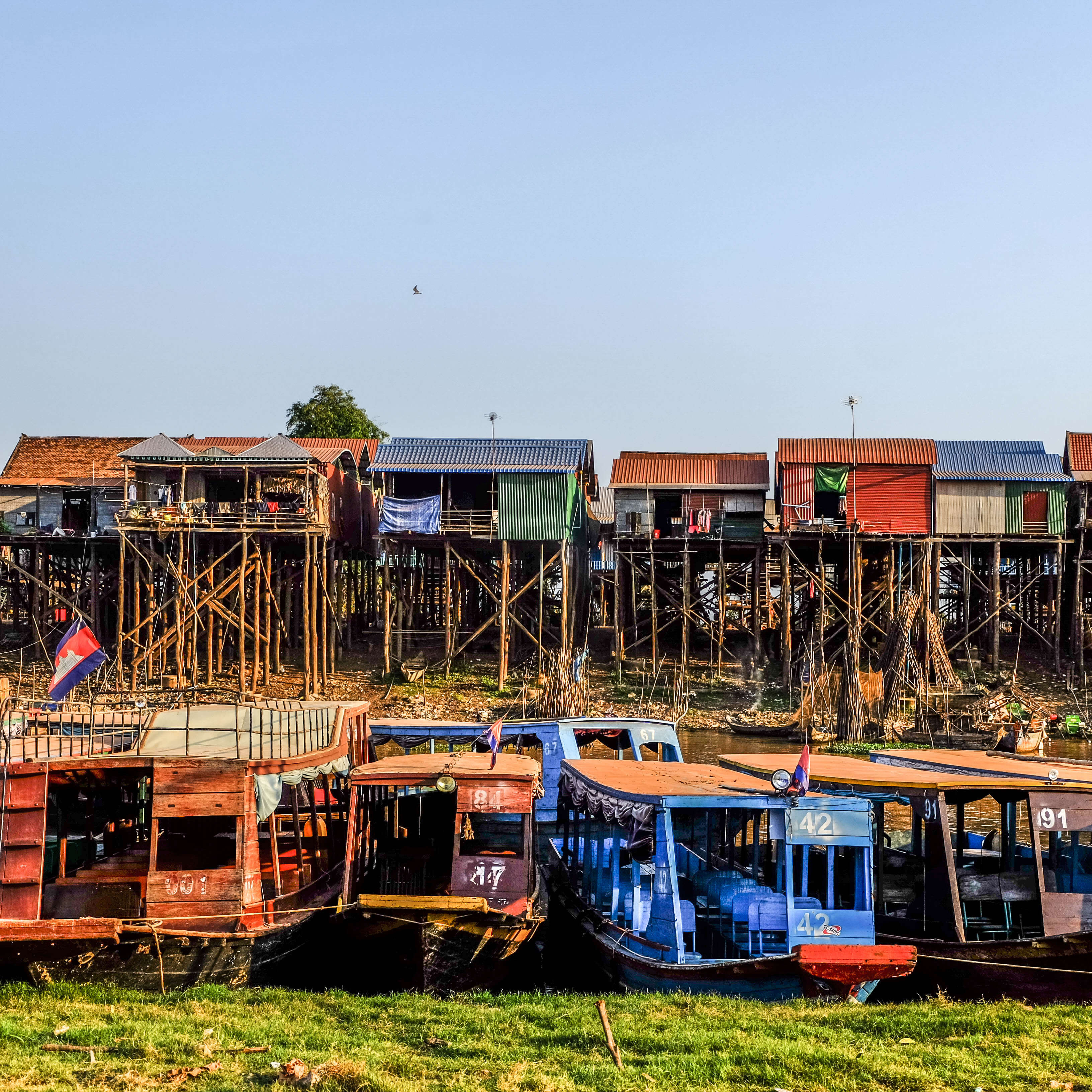
Many floating villages of this type can be found around the Tonle Sap Lake, and more than 1.2 million people call the Lake home, supporting themselves through harvesting the resources of the Lake.
Some of these villages are built on stilts, whose structure emerges during the dry season, when the water level recedes. From December through April, the waters of the lake withdraw considerably, leaving these villages high and dry off the ground.
Other villages consist of floating platforms, which rise and fall with the water level of the seasons. These platforms can be anchored near the shores of the lake during the wet season, when the water is abundant; while during the dry season, they move towards deeper waters in the center of the lake.
Most of the inhabitants are of Vietnamese origin, especially those who live in houseboats. Although many of them were born and raised in Cambodia, not everyone has an ID or a birth certificate that proves their Cambodian citizenship. The law denies land ownership rights to those who are not citizens, so these people have found a solution by living off the shores of the lake, finding in houseboats the only opportunity to continue living in places they had lived for generations. Unfortunately, their status as recognized non-citizens greatly diminishes the possibility of finding a good job, or accessing education. The only way to survive is to fish the waters of Lake Tonle Sap.
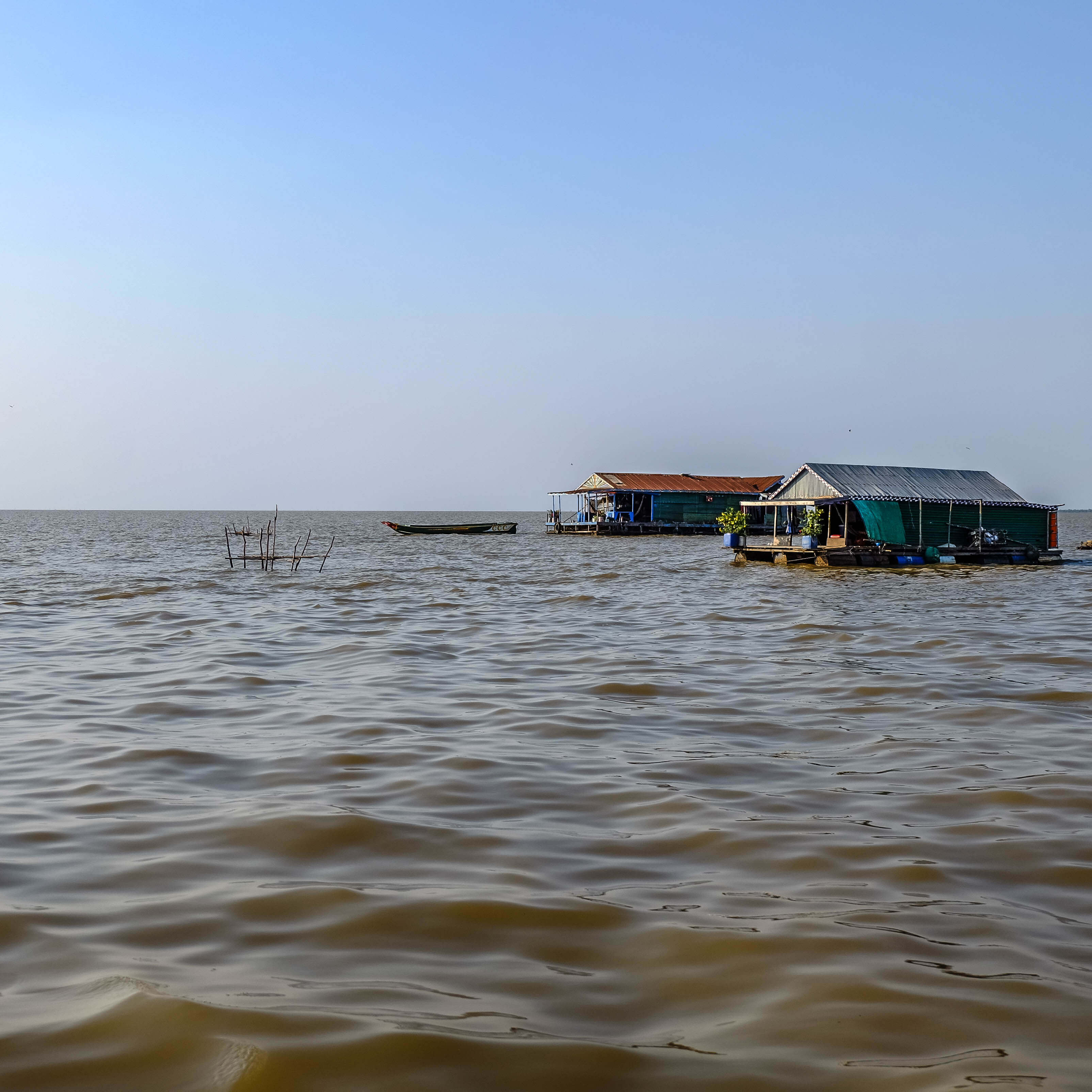
HOW TO PREPARE FOR A VISIT TO THE FLOATING VILLAGES
BEWARE OF POSSIBLE SCAMS
There are many floating villages around the Tonle Sap Lake, but just a few can be easily visited with a half day trip from Siem Reap.
Unfortunately, the tourism in some of the most popular floating villages is run by infamous ‘companies’ that carry out scams at the expense of both the visitors and the residents of the villages.
In fact, the profit made from the sale of entrance tickets (which is quite expensive), does not benefit the village community at all. Also, tourists claimed to be forced into buying ridiculously priced goods to donate to the children of the village, who never received any of it. Sometimes expensive tips are demanded in intimidating ways.
For this reason is important to be well prepared and have a clear idea about which village to visit. These are truly beautiful places and would be such a pity to have this beautiful experience ruined.
BEWARE OF THE TICKET PRICE
It is sad, but fair to say, that an excursion to the floating villages can turn into a rip off if you are not well prepared.
First of all, the ticket price is quite expensive.
The official prices are really hard to confirm. During the preparations for this excursion, I read many websites, tourist guides, and contacted many people who had been there recently. Everyone, talking about their experience, told me different prices!
It appears that the prices vary according to the season, the discretion of the ticket salesman, the tour operator on duty, and your ability to negotiate.
Ultimately, a ticket for a one person boat excursion purchased directly from the village should be around $20, or $30 from a tour company operator. So don’t be shy, and if the price seems too high, try to bargain!

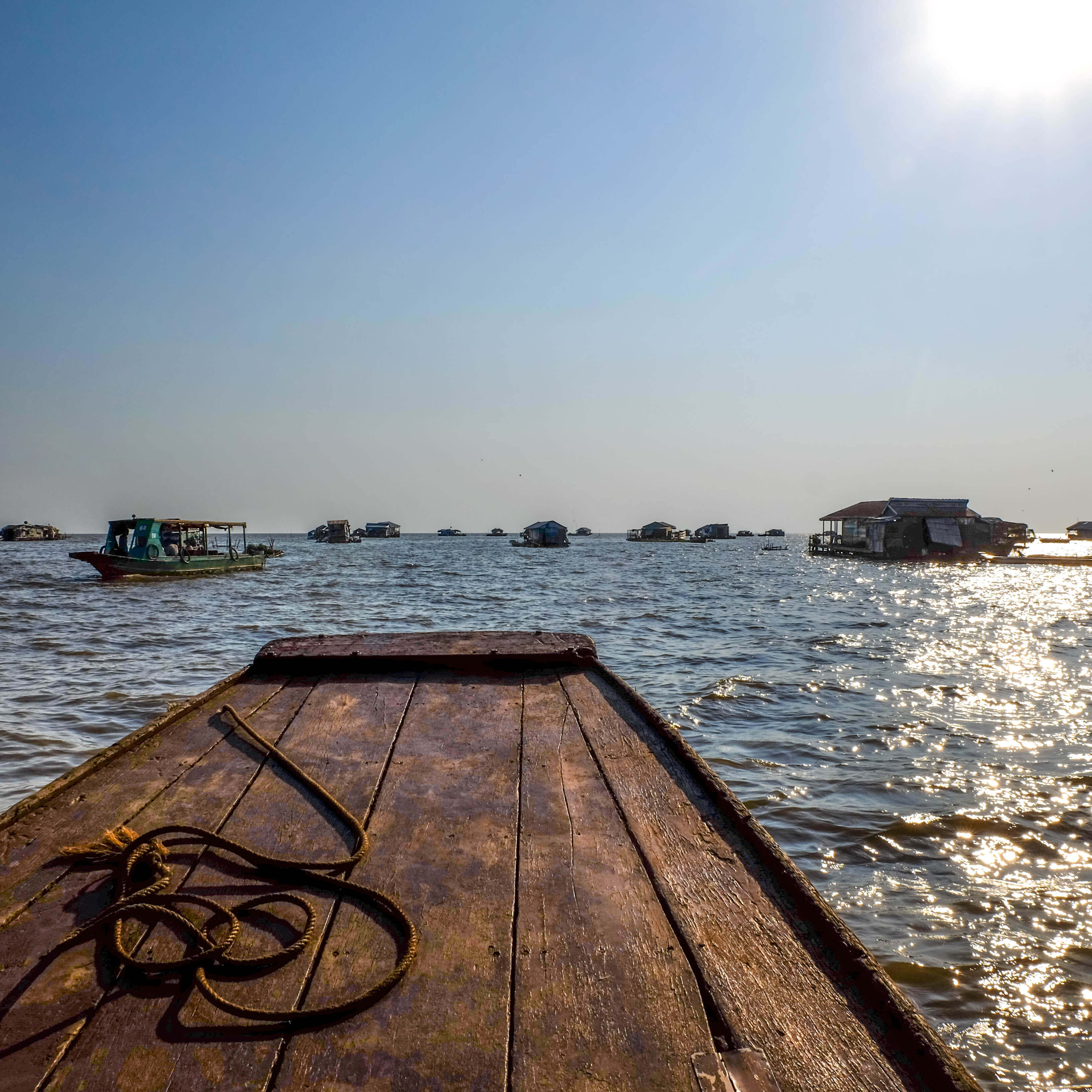
WHICH IS THE BEST FLOATING VILLAGE?
There are four floating villages that are normally visited. In order by distance from Siem Reap, there are: Chong Kneas, Mechrey, Kompong Phluk, and Kompong Khleang.
The best pick is Kompong Khleang, which is almost 60 km from Siem Reap, but is the largest, most authentic, and least touristic village. This village also isn’t known to be involved in tourist scams.
In Kompong Khleang, it is possible to admire both stilted houses and floating houses, with the profits going directly to the community.
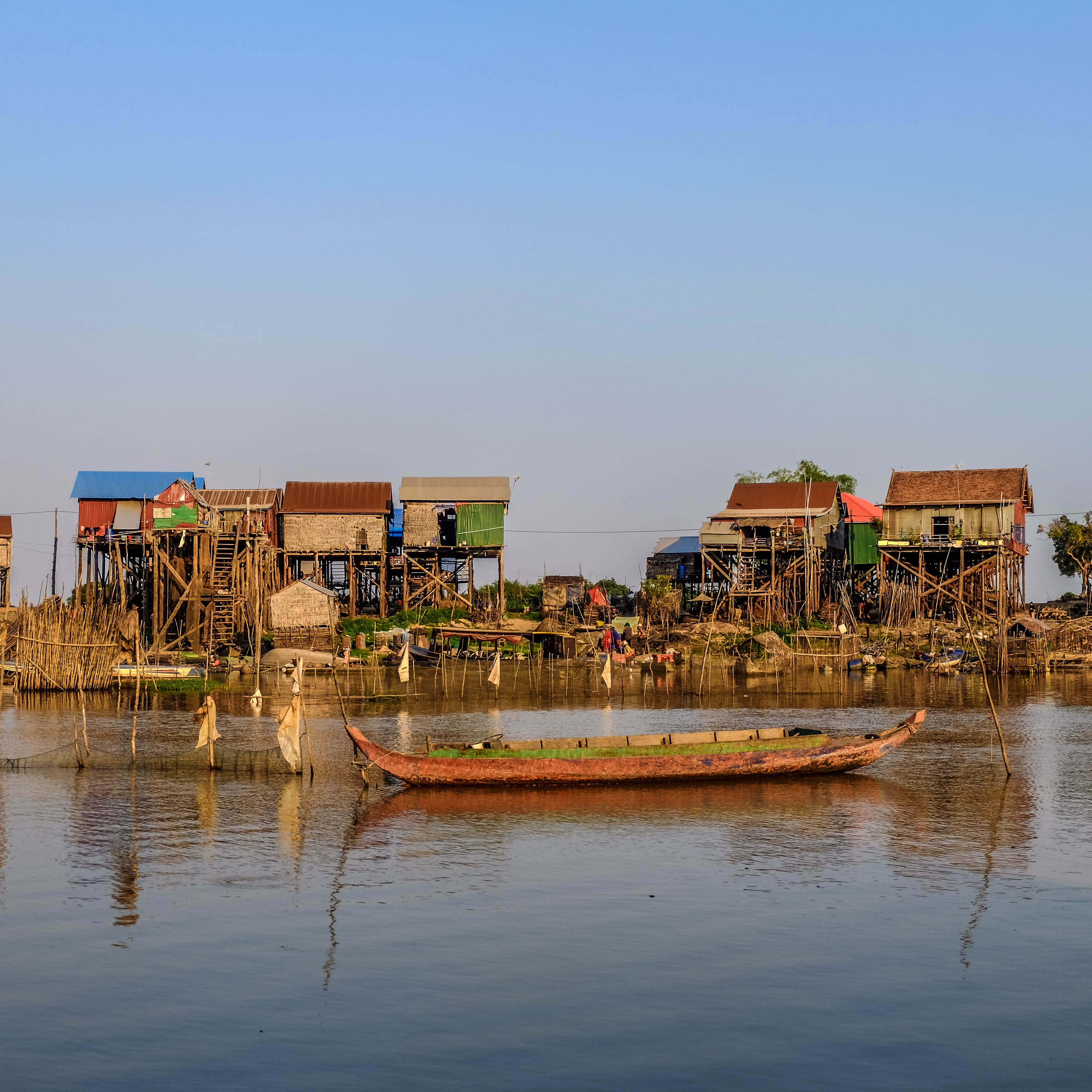
VISITING KOMPONG KHLEANG FLOATING VILLAGE DURING THE DRY SEASON (FEBRUARY)
Our visit of this village was one of the best highlights of the entire trip. After all the research I had done on floating villages, I could not wait to experience it in person. We were only able to visit one with our schedule, so I wanted to do it right. I was determined to go to the most stunning place, and I believe we chose the best option!
Kampong Khleang is composed of two parts: a floating part and a fixed part on stilts

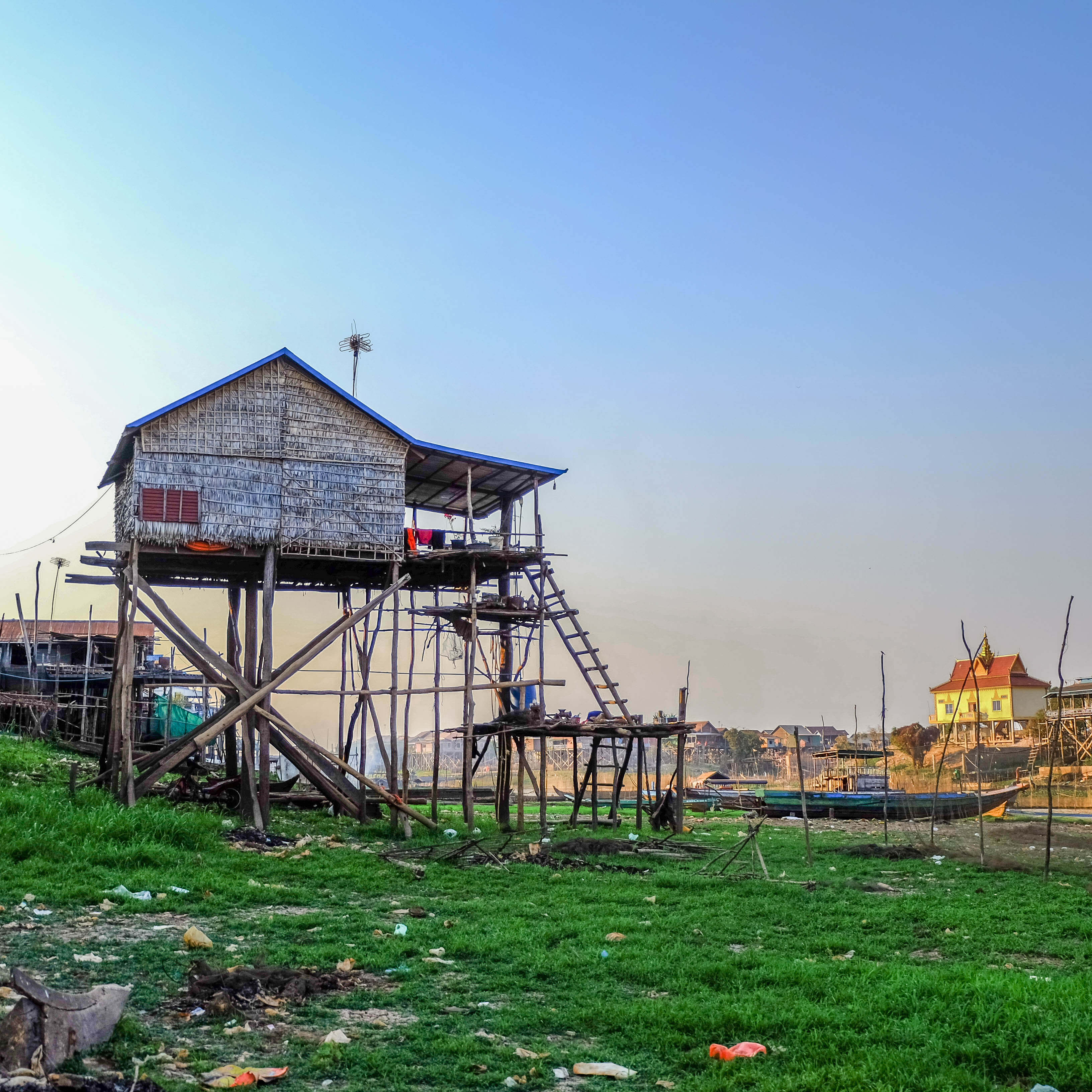

The stilted homes are built along both sides of the river, with roads running along beside them. During the wet season, the roads are completely submerged by the rising waters of the Tonle Sap lake. From May to November, much of the pedestrian part of the village is flooded, with the water concealing the stilt structures, leaving the houses “floating” on the swollen lake.
During the dry season, the red clay roads are dusty, colorful and lively, while the river flowing in the middle of the village is reduced to a shallow canal, still navigable by small boats.
During the dry season, you can also see how the inhabitants cultivate part of the lakebed.
Our visit fell in the middle of the dry season (February 2019), and we found the dry village even more interesting! Being able to see the village ‘naked’ was truly incredible and the stilted structures (some are up to 6 meters high!) left us in awe.
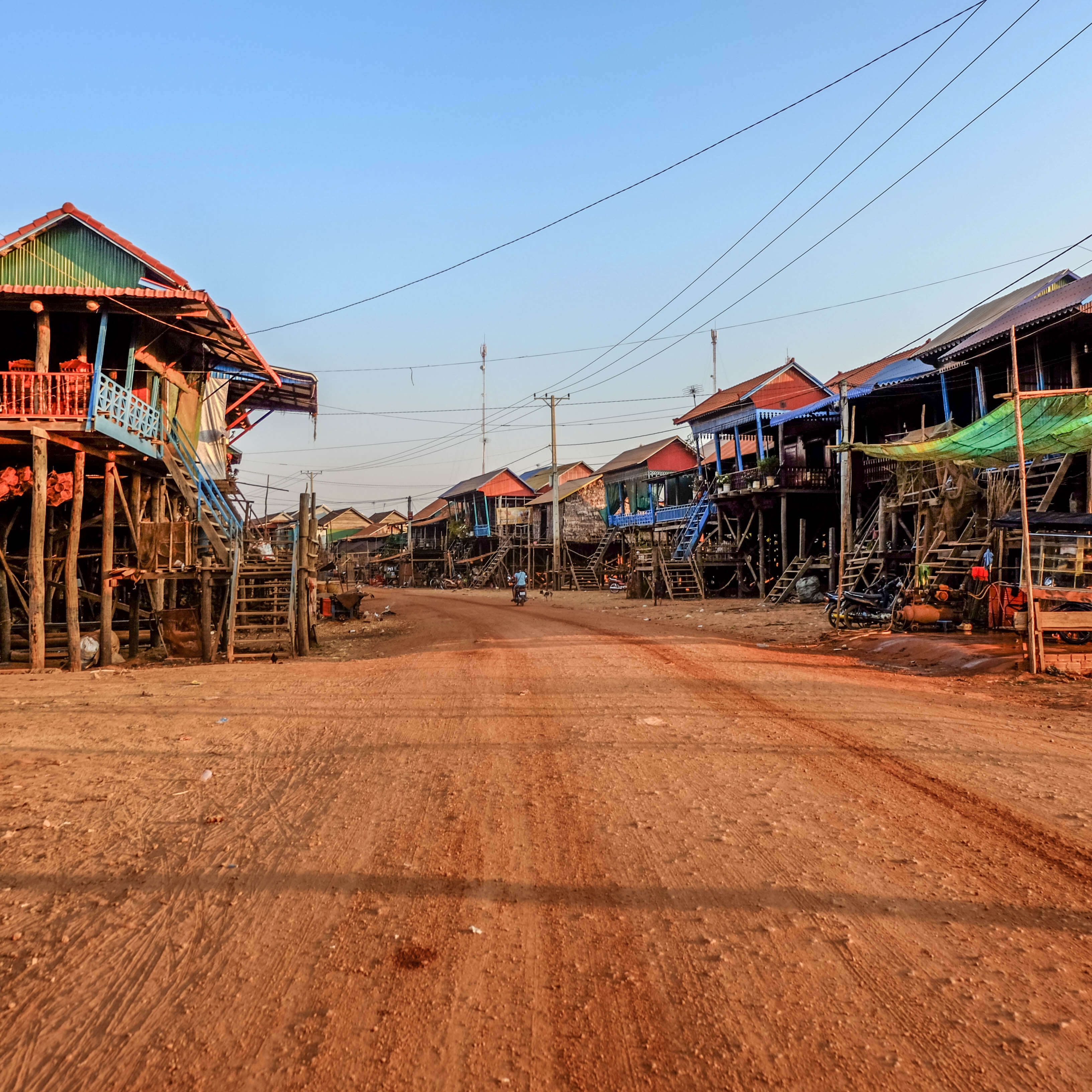
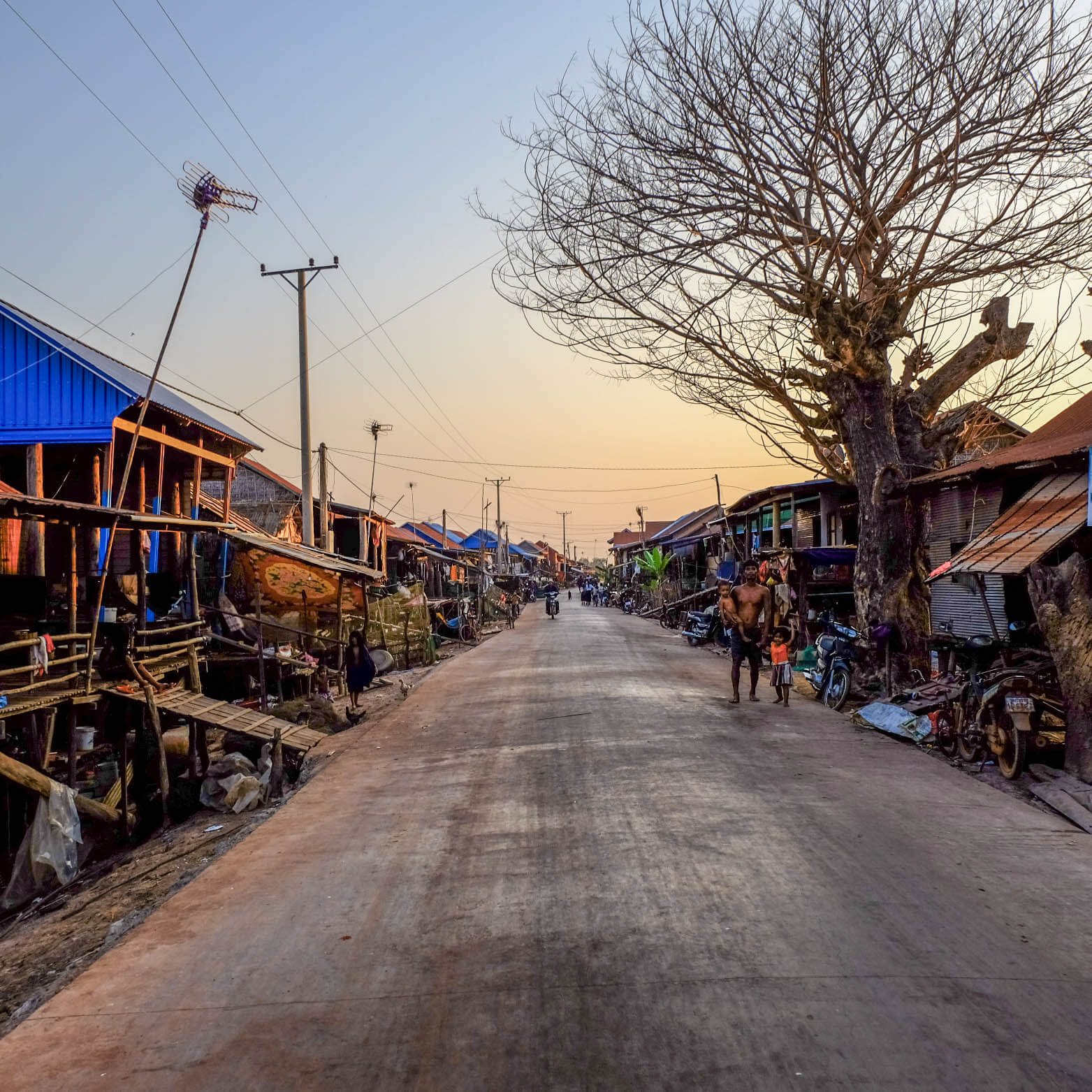
After arriving at the village, we purchased our ticket and set off on our tuktuk through the dry part of the village. A few kilometers later, we reached a small port on the river, where we got on a boat driven by two young locals. We were the only tourists there, meaning we could enjoy a boat to ourselves.
Judging by the quantity of the tourist boats at the deck, I would guess they expect a greater number of visitors during the wet season. During the course of the afternoon we only saw two other tour boats out with people.
The excursion lasted about an hour and a half, and led us to deeper waters, where we could admire the floating part of the village.
Motoring along the canal, we passed an elementary school, church, and several floating dwellings, before reaching a wider point where several floating houses were anchored. This part of the village moved according to the seasons, adjusting with the rising and falling water level.
Once back on the ground, we walked back through the dry village, marveling at the architecture adapted to the lake lifestyle of the locals. busy during their everyday activities.
The villagers seemed busy with their daily routines, but they were very welcoming towards foreigners, allowing us to snoop around undisturbed. Smiling benevolently, we wandered by the houses, and down a canopied alley as children greeted us.
Almost 4 hours and over 100 km on a tuktuk to get to Kampong Khleang was absolutely worth it, and we basked in the glory of the setting sun on our ride home. This incredible place was undoubtedly one of the most beautiful places we visited in Cambodia. We experienced a truly unique part of Cambodian life on Tonle Sap Lake, whose waters provide for the whole country.


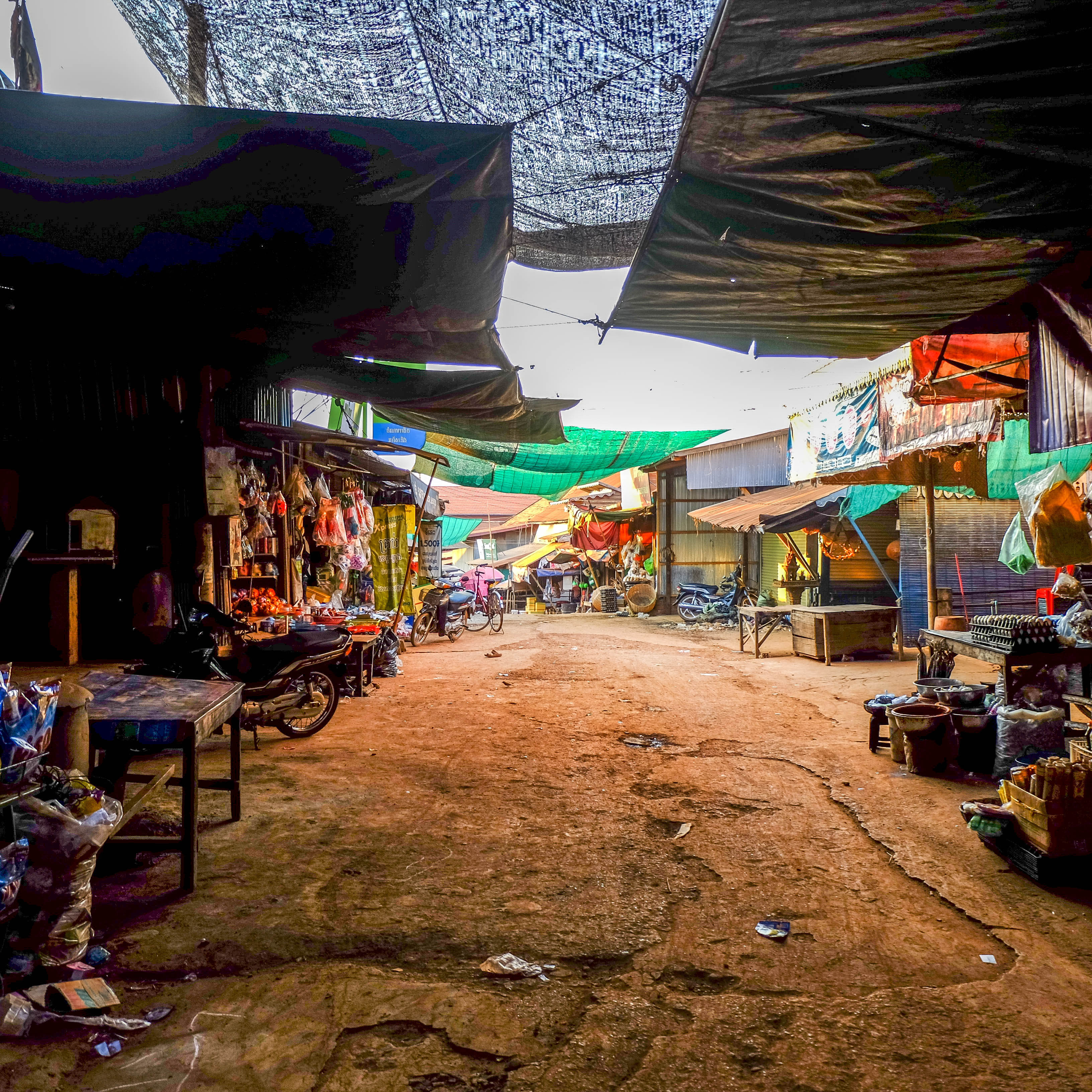
HOW TO VISIT KAMPONG KHLEANG – PRACTICAL TIPS
- The village of Kampong Khleang is about 60 km from Siem Reap, which is about 2 hours by tuktuk (we paid our driver $20). Most of the time, the road is a normal provincial road in good condition (considering the state of many Cambodian roads full of holes and gravel). Only the last stretch is composed of red earth dirt road, which is a bit bumpy, but nothing terrible. We decided to hire a tuktuk driver rather than rent our usual motorbike because many guides on the internet warned about the poor state of the road. I cannot say how the condition of the dirt road will be during the wet season (some guides say that it becomes muddy and part of the road submerges).
In that particular February, during the dry season, the journey on the scooter could have been done; no problems. However, the tuktuk choice turned out to be very relaxing, and over 100 km on one scooter under the hot sun would have been challenging. - At Kampong Khleang, the price of the entry ticket is not clear. I read about prices ranging from $20 to $10 at the discretion of the sales man and the insistence of bargaining. We were asked to pay $30 per person, which we bargained down to $20. The salesperson initially seemed unwilling to negotiate (along with us in the ticket office there were other tourists who paid $30 without a word), but eventually he agreed to lower the price.
- Supposedly, the income derived from the sale of Kampong Khleang tickets goes directly to benefit the community of inhabitants. We hope so!
- The ticket includes a boat ride to part of the floating village that lasts 1 hour and 40 minutes. At the time of our visit, we met only a handful of other visitors, which allowed us to have the boat privately chartered.
- We started from the center of Siem Reap at 13.30, arriving in Kampong Khleang around 15.30. The timing turned out to be perfect, as we were able to enjoy the pleasant afternoon light during our boat trip. The warm glow of the sky before sunset proved to be perfect for taking pictures.
- It is possible to visit Kampong Khleang without tour agencies and DIY is the method we prefer in our travels. However, weighing everything at the end of the excursion (ticket + tuktuk), there does not seem to be significant price differences compared to booking a tour. A recommended tour is Community First Kampong Khleang, which promote responsible tourism that reinvests in the local community.
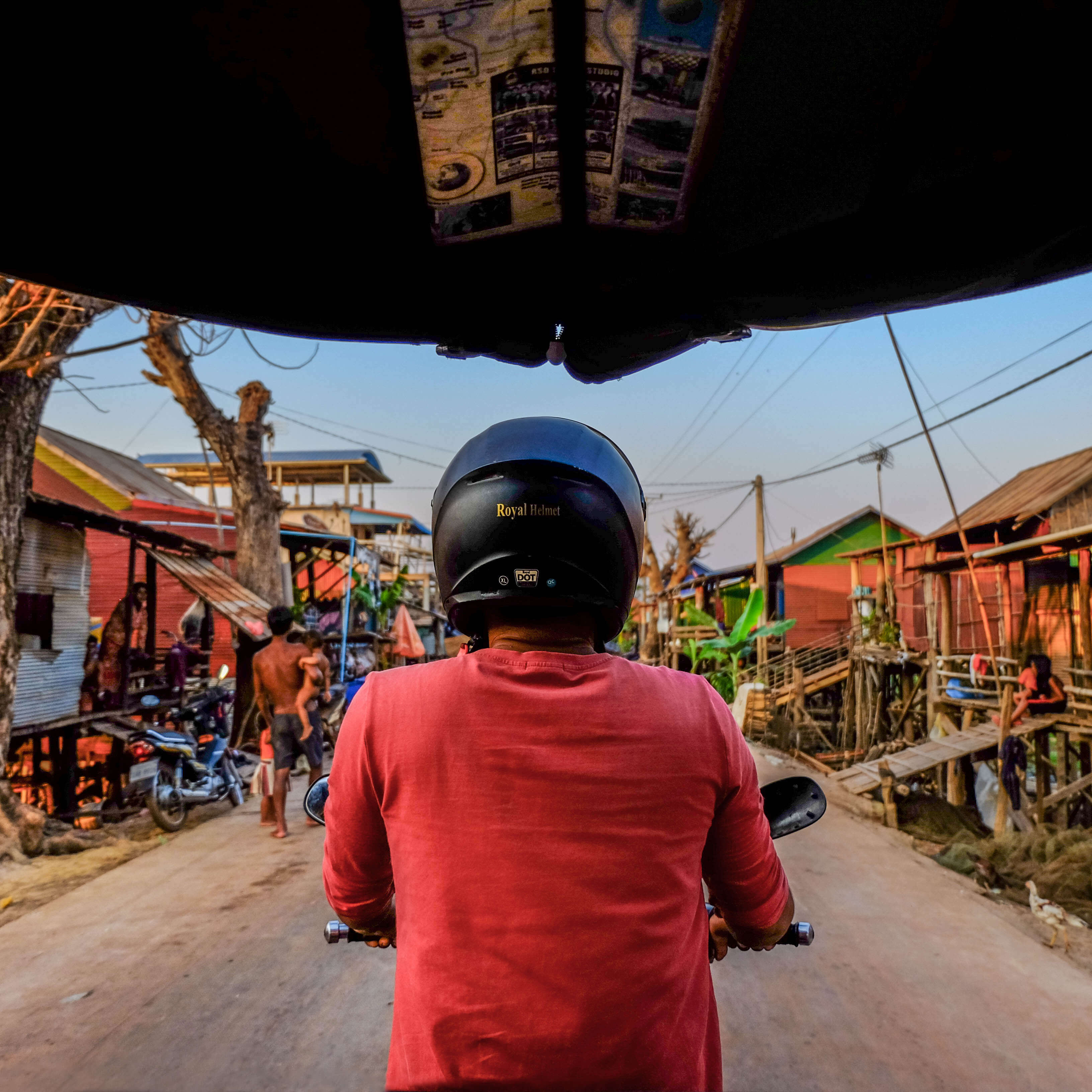
OTHER FLOATING VILLAGES AROUND SIEM RAEP
CHONG KNEAS
Chong Kneas is the floating village closest to Siem Reap (around 15km), and consists of floating houses on platforms that move according to the depth of the lake.
Of all the floating villages it is the most touristic and should be avoided. I have heard and read terrible reviews about this village, because it is in fact a big tourist trap. Local tourist businesses are in fact conducted in a way that is actually harmful for the local community.
Many tourists have complained that they have been victims of fraud, the most common is to be practically forced to buy 20-50 kg rice bags (for the ridicoulus price of $ 20-50) to donate to the village’s orphan school. However this food does not reach children, but brought back by the scammers and sold directly to the next boat of tourists.
The cost of the ticket to participate in the excursion (lasting about 1 hour) is around $ 20 (plus the price of the mandatory food offer)
One way to avoid such scams is to rely on tour agencies, like the Tara River Boat based in Siem Reap, which seems to be one of the few legit tour operators that covers excursions in this floating village (expect to pay around $ 30 for a half day excursion).
However in my opinion it is better not to encourage this unhealty tourism, so if possible it is better to visit other more responsable an ethical floating villages.
MECHREY
Built on boats and floating platforms similar to Chong Kneas, the small floating village of Mechrey is recently gainig the unfotunate fame of being a tourist trap too. Many tourists infact reported to have been the victim of the famous scams of rice bags donation to the orphans.
KAMPONG PHLUK
Located around 30km from Siem Reap, the floating village of Kampong Phluk is built on stilts and it’s significantly smaller and crowded than the other stilted village Kampong Khleang.
During the dry season is possible just to walk or ride through the village, admiring the stilted structures, and having a taste of the local life on the ground.
The ticket to take a boat excursion on the lake (which includes also a cruise through the impressive flooded mangrove forest) is around 25$ for the cheaper option (price updated on February 2019 during the dry season… the price may varies in other times of the year…).
It’s possible to visit Kampong Phluk by yourself or joining a tour from Siem Reap, without booking through a tour company.
IF YOU FOUND THIS POST INTERESTING AND INSPIRING, HELP ME TO SHARE IT WITH OTHER TRAVELERS!
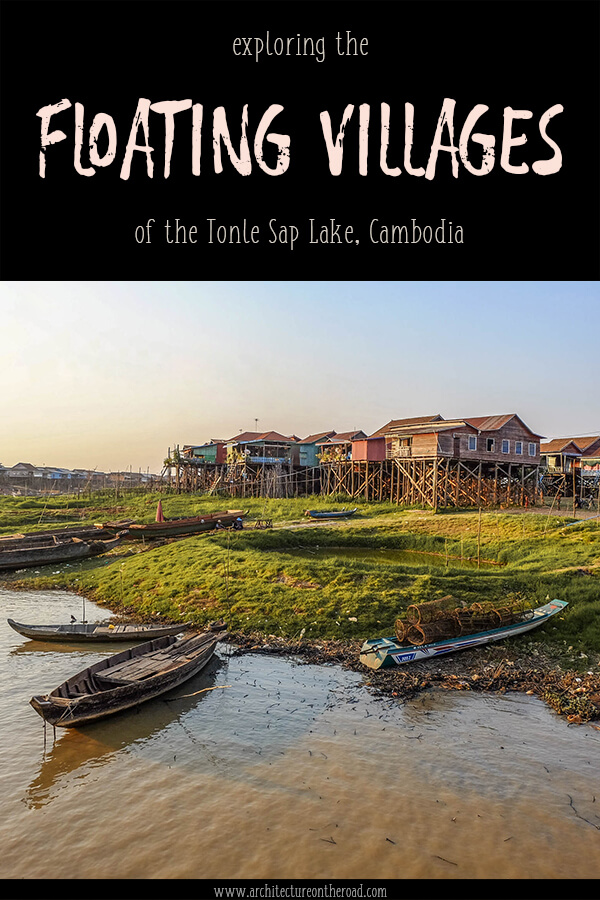
More from Cambodia
stay tuned !
search for a destination
latest travel itineraries
latest Cambodia articles
Text and pictures by
Architecture on the Road ©
Architecture on the Road
All rights reserved
All photographs on this site were taken and are owned by me (unless credited otherwise).
If you would like to use some of these photos for editorial or commercial purposes, many of these are available on Shutterstock (click the link below). Otherwise, please contact me on Instagram, Facebook, or by email.
Do not use my pictures without my written consent. Thank you!


Comments
Molto interessante! Grazie per i consigli direi indispensabili per affrontare questo particolare viaggio.